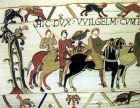STATIONS OF THE CROSS, c. 1600s CE
Many of us are confronted with a rather profound work of visual storytelling whenever we step foot within a church. The work in question is a common installation called "The Stations of the Cross," which generally came to be recognized as such in the fifteenth century. These stations tell the story of the execution of Jesus of Nazareth and are often arranged around a church as either inscription-bearing sculptures or plaques, or, in some instances, stained-glass windows. Each station bears a title, such as "Jesus falls the first time," or "Jesus is stripped of his garments." As has been noted of William Hogarth's "A Rake's Progress," the stations effectively form a storyboard or visual narrative of an important sequence of events in a person's life.
You can find a neat activity to do with students that's inspired by visual narratives like the Stations of the Cross (and A Rake's Progress) under the Activities tab. It's Activity 4--Wordless Narrative.





